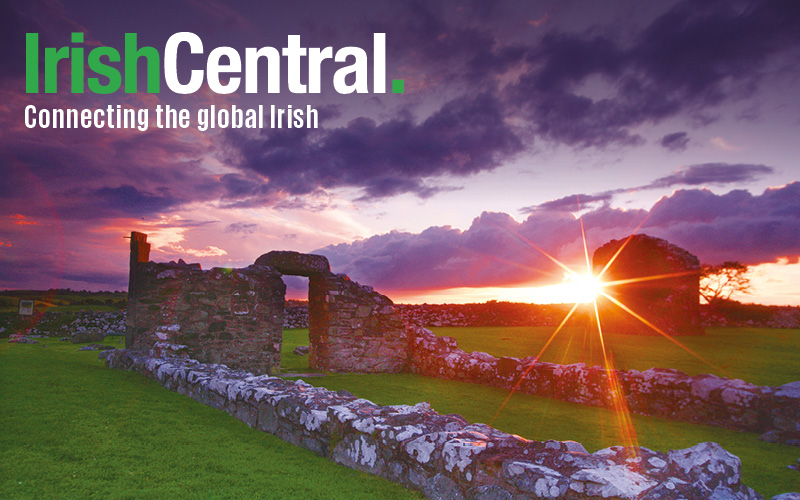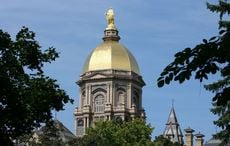On the day he assumes the highest office in the land, Barack Hussein Obama, the descendant of Ohio and Indiana immigrants who came from the borders of Counties Offaly and Tipperary, will join an exclusive club of twenty Presidents who claim Irish ancestry. President Obama’s single Irish great-great-great-grandparent puts him at thirteenth position in an informal ranking, alongside James Polk and just ahead of Richard Nixon, whose Quaker immigrant ancestors also came from Ireland to Ohio and Indiana. But the new president’s foreign-born father admits him to a smaller and more distinguished group of four that up to now has been exclusively Irish (the parents of Andrew Jackson and James Buchanan, and the father of Chester Arthur were all born on the island of Ireland). And unlike many of his Irish-descended presidential predecessors, Barack Obama has a relatively close link to his forebear Fulmoth Kearney, who left Moneygall in County Offaly (then known as King’s County) in 1850. Barack was nine years of age when his great-grandfather Ralph Waldo Emerson Dunham (Fulmoth’s grandson) died in 1970 at the age of 76. The former Kansas cafe owner and auto mechanic, who had retired from Boeing as an aircraft fitter was well into middle age by the time his Irish mother died in 1936, on the same day as her husband Jacob. Born in 1869, Mary Anne Kearney Dunham, Ralph’s mother, was Fulmoth Kearney’s youngest daughter, and she too was nine years of age when her father died, almost three decades after he had arrived in America on the good ship Marmion. Although most of the media attention has focused on Fulmoth, the unusually named mid-19th-century immigrant, members of the family were in America from the early 1780s, when the Protestant Kearneys were still prominent in Shinrone, a more extensive King’s County community eight miles north of Moneygall. There the family patriarch, 85-year-old Joseph, was presiding over the decline of a small textile and property empire he had set up with his enterprising brother Michael, a successful Dublin wig-maker and father of Trinity College Provost and later Protestant Bishop of Ossory, John Kearney. Joseph’s grandson Thomas (c. 1765-1846) was the first to leave Ireland, settling in Baltimore and offering his services as a master carpenter (it is tempting to speculate that he might even have been engaged in building The President’s House). By 1791 Thomas had married 17-year-old Sarah Baxley of Fairfax County at Baltimore Methodist Church, and within a decade they had taken up a land grant in Ohio, where they settled in Ross County near the site of the future county seat of Chillicothe. There Thomas was joined by his 23-year-old tailor brother John (1782-1870). Their brother William, a Moneygall shoemaker and small-scale tenant farmer, then watched as virtually all his children – Sarah, Thomas, William, Margaret and Francis – emigrated and settled near their uncles in the American Midwest. In Ohio, Francis Kearney’s early efforts at farming were relatively successful so that by the time he died in 1848, he had a sizable holding along the line between Pickaway and Ross Counties. The Ross County lands, located on the North Fork of Paint Creek, he willed to his 54-year-old brother Joseph, the only one of his generation left in Moneygall. Joseph had inherited his father William’s shoe-making business on the latter’s death in 1828, and he and his wife Phoebe were well settled in the small King’s County village. They had four children, ranging in ages from twenty-two downwards. Margaret, the eldest, was already married to William Cleary, who was more than twice her age. Her brother Fulmoth, named for his maternal grandfather Fulmoth Donovan of Ballygurteen, was eighteen, and the two younger siblings, William and Mary Anne, were fifteen and eleven respectively. Within a year, Joseph, his wife and family had made the decision to leave Ireland and by 1851 the two parcels of land that made up the smallholding near Moneygall (still known today as ‘Kearney’s Fields’) were put up for public auction by the then landlord, Rev. William Minchin, who lived at nearby Greenhills. The 63-year-old Protestant rector of Dunkerrin parish was selling his debt-laden estates and moving his family (which numbered nineteen in total) lock, stock and barrel to Australia and New Zealand. In an interesting sidelight, Fulmoth’s Uncle Thomas, who died in 1845 in Wayne Township, Ohio, at the age of 45, has no recorded spouse, but his will refers to a son, Thomas, then living in Ireland, and to a favorite niece with the fateful name of Anna Minchin, indicating a connection with the landlord family. Meanwhile Fulmoth Kearney married a local girl named Charlotte Holloway. The family (which would eventually include nine children) later moved to Tipton County in Indiana, just south of the present day city of Kokomo, and north of Indianapolis. Sadly, the story was not all one of hope and joy: Fulmoth’s siblings, William and Mary Anne, who had come from Ireland as teenagers, died in their twenties in 1855 and 1866 respectively, and his sister Margaret’s husband William Cleary died in 1862. By the early 1870s, Fulmoth and Charlotte Kearney’s eldest daughter Phoebe was attracting the attention of a young man whose family had moved from West Virginia to the Tipton community some years before. He was David Dunham, one of the seven children of Jacob and Louisa Dunham. When he married Phoebe in 1873, they were both nineteen. Three years later David Dunham’s brother Jeptha married Martha Kearney. Within two years of Martha’s wedding, the Kearney family lost both parents (Charlotte died in 1877 and Fulmoth in 1878, while still only in their forties). Mary Anne was nine and was raised by her older married sisters. This situation resulted in the sealing of the Dunham connection twelve years later with her marriage to a third brother, 29-year-old Jacob, who had already established himself as a druggist. Jacob and Mary Anne’s second son, one of seven siblings, was Ralph Waldo Emerson Dunham Sr., Barack Obama’s great-grandfather. Of Ralph’s brothers and sisters, all born before 1900, some were still living as late as 1980, and the husband of one died only in 1991. Ralph Waldo Emerson Dunham’s son, Stanley Armour Dunham, became the beloved grandfather who with his wife Madelyn Payne ‘Toot’ Dunham raised Barack Obama from the age of ten. Stanley’s life and progress as furniture salesman in Kansas, Texas, Washington and then Hawaii has been well documented in his grandson’s books Dreams from My Father and The Audacity of Hope. His death in 1992 deeply affected the thirty-one-year-old community activist, who married lawyer Michelle Robinson later in the same year; three years later, Barack’s mother, Dr. Stanley Ann Dunham, died at the age of fifty-four. From these inspiring alliances and devastating losses would grow the strength of character that was to lead to Barack Obama becoming one of the forty-two (George Washington was the exception) chief executives who have occupied the most famous residence in the world – one that was built, rebuilt, extended and staffed by Irish and African-Americans, working side by side, during its two-hundred-odd years as executive mansion. African-American and Irish Connections at the White House In 1790, the first plans for the setting out of a street grid in the new capital of the United States involved two interesting characters, both mathematicians: Benjamin Banneker, the African-American grandson of Molly Walsh, thought to have been an Irish-born indentured servant, and James Dermott, an Irish-born teacher at an Alexandria school attended by the extended family of George Washington. Banneker’s almost photographic memory of the marker placements in the original survey of the Maryland side of the Potomac River allowed him to recreate for the Ellicott brothers the outlines of streets and circles as conceived by Pierre Charles L’Enfant after the latter’s dismissal by President Washington. Dermott saw opportunity here and moved from his teaching post to becoming an early entrepreneur in the new Federal enclave. His 1792 survey of the capital site gave him an important foothold in the ordering of the early civil works that prepared the way for the construction of the President’s House and the U.S. Capitol. Dermott’s slaves helped to haul the Aquia stone from the barges at the Potomac landing to the elevated site where the executive mansion would rise, but it took another Irishman and his slaves to bring the project to fruition. Kilkenny-born architect James Hoban brought with him the most talented and dependable of his slave carpenters and brick-makers from Charleston SC, where he had run a small construction business and drawing school with fellow-Irishman Pierce Purcell. Hoban and Purcell’s flexible regime ensured that the slaves were recognized for their skills, and for their ability to supervise the less experienced slaves hired from Maryland and Virginia estate owners. Although Hoban maintained a business and a personal household dependent on slave labor to the end of his life, he insisted that on his death the South Carolina slaves be allowed to remain in the District of Columbia, where a more enlightened regime was in place in a territory largely controlled – then as now – by the U.S. Congress. From the early 1800s, when one-third of the new city’s population was African-American, education became more accessible, property rights were extended, and government employment was open to the increasing number of freedmen, who outnumbered slaves almost ten to one by mid-century. In Thomas Jefferson’s time, the Virginian’s relaxed approach to both race and fashion resulted in a strange household at 1600 Pennsylvania Avenue. While Jefferson shuffled around in stained jacket and slippers, his house staff of freedmen and slaves were turned out in a fetching livery of blue and red ‘with plated buttons and a decorative woven edging in silver.’ Presiding over all was Derry-born major domo Joseph Dougherty, who with his wife Mary and brother Robert, effectively ran a domestic team that also included a French chef, a German butler, and an Irish washerwoman named Biddy O’Boyle. When he assumed the Presidency in 1808, James Madison brought from his Virginia estate an interesting trio who represented the amazing diversity of the young independent republic. Charles Bizet was a talented French horticulturalist who had looked after the Montpelier landscape; the African-American Paul Jennings was Madison’s trusted personal servant; and Irishman Thomas McGrath was an assistant to Bizet, whom he helped in organizing the vast untamed spaces around the executive mansion. It was McGrath who ‘rescued’ Gilbert Stuart’s famous portrait of George Washington from the impending conflagration when the British slashed and burned their way through Washington City in 1814; and it was James Hoban who returned with his trusted team of Irish and African-American laborers to rebuild The White House. Andrew Jackson brought from his Tennessee estate a highly-regarded personal servant named George Washington Jackson (who, in the manner of the time, shared both name and sleeping quarters with the President) and also employed a doorkeeper named Jemmy O’Neil – both were African-American. Although Thomas Jefferson’s tree plantings in the grounds of the President’s House were beginning to take shape, the destruction of the capital and its largest building by the British in 1814 required that the entire area be re-planned and replanted. It was Jackson who carried out the most ambitious undertaking in this regard, using the services of the Irish-born Jemmy Maher, an Alexandria nursery owner who became the official gardener to Washington City, and some of the slaves he had purchased from Colonel Hebb or brought from his huge complement (150 by the time he died) at ‘The Hermitage.’ In the mid-nineteenth-century administrations from Van Buren to Pierce, the White House door was kept by Kilkenny-born Martin Renehan, a trusted presidential adviser. Renehan became a prominent local grocer when he retired, and enjoyed the custom of many of his former African-American colleagues (most of them now unemployed – President James Buchanan, son of a wealthy Donegal-born merchant and the only bachelor to serve in the highest office, decreed that only British subjects should be employed on the staff of his White House). But elsewhere African Americans continued to make inroads into the ranks of paid and respected government employees in Washington, and it was President Andrew Johnson, the grandson of an Antrim-born immigrant, who appointed William Slade, Abraham Lincoln’s personal messenger and friend, as the first African-American steward of the First Residence in the wake of the Civil War. In 1948, when President Truman ordered the gutting of The White House and the restoration of George Washington’s ‘lost’ third floor, the massive refurbishment was carried out by the construction firm of John McShain, the son of a Derry-born carpenter who emigrated to Philadelphia in 1885. As in the case of the Pentagon, where five years earlier McShain had completed over five million square feet of space for 40,000 employees in less than two years, much of the excavation and structural work was carried out by Irish and African-Americans working side by side. President John F. Kennedy’s appointment of Andrew Hatcher as Associate Press Secretary was the first senior posting of an African-American in the West Wing, at the same time as his wife Jacqueline was planning the famous Rose Garden with Rachel Mellon, wife of the financier Paul, who was the grandson of Tyrone-born Thomas Mellon. The Obama White House may not be as ‘Irish’ as the Kennedy one, but its African-American credentials have already been secured. The day-to-day running of the most high-profile household in the world is in the hands of Chief Usher Admiral Stephen Rochon, a former Coast Guard officer with a passion for historic preservation, and Social Secretary Desiree Rogers, a convent-educated native of New Orleans. And long before the question was raised as to whether an African-American should be elected to lead the nation or run its executive mansion, the question of whether one should ‘rule’ the national capital had been settled, as it has in many other major American cities. In the early years of American independence, there were prominent Irish community leaders in Alexandria (Rathdowney-born John Fitzgerald, a former aide to George Washington), Georgetown (Limerick-born shoemaker and merchant Thomas Corcoran) and Washington City (where Thomas Carbery was one of a handful of Irish council members – with James Hoban – and served as mayor from 1824). But since 1967, when the appropriately named Walter Washington first took office as President of the Board of Commissioners, the head of local government in Washington D.C. has always been from the city’s majority African-American population. Forty years on, nearby Baltimore got its first African-American, and first female, mayor in Sheila Dixon, who succeeded Governor-elect and prominent Irishman Martin O’Malley. And so as Barack Obama stands outside the iconic building that will be his home for the foreseeable future, and looks across Lafayette Square at the statue of Andrew Jackson on his rearing steed, he may sense a number of unearthly presences. Some will be the spirits of his revered departed – the parents and grandparents who helped to shape the most tradition-shattering figure in American presidential politics since John F. Kennedy. But others may well be the ghosts of all of those prominent Irish and African-American ancestors and pacemakers and builders – and the hundreds of every race and nation who have thronged the hallowed halls of The President’s House during more than two hundred years. They will be looking on in disbelieving fascination at the most momentous gathering since Andrew Jackson threw open the doors to one and all at his infamous inaugural ‘levee,’ when ‘All Creation Went to the White House,’ as it will again on January 20, 2009. Note: Genealogical information used in this article is based on preliminary research by Eneclann, Ancestry.com and Roger Kearney of Troy, Ohio (including the latter’s transcriptions of tombstone inscriptions and wills), as published on their websites and may be subject to later amendment or revision.




Comments